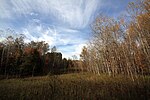Happy Valley Forest is a 6.48 square kilometre provincially significant ecological area, classified as an Area of Natural and Scientific Interest by the Ontario Ministry of Natural Resources. It consists of an upland forest on steeply rolling topography, various wooded swamps, and minor wetland areas (wet meadows, thickets and cattail swamps). A few small kettle ponds are also present.
Located on Ordovician bedrock over the Oak Ridges Moraine, the forest attains elevations between 122 and 152 m, increasing westward. The majority of the area is composed of overburden of ice-contract stratified drift of sand, gravel and silt of varying origin (kame, outwash or collapse). Soil types in the forests are predominantly pontytool sandy loam; Brighton sandy loam, King clay loam (southern and western steep areas), and bottomland (along stream banks) are present in small areas.
The upland forest is dominated by sugar maple in most areas, and sugar maple and American beech in others, though species such as paper birch, white ash, eastern hemlock, black cherry and red oak are found throughout. The eastern portion is instead dominated by red maple and red oak, interspersed by American beech, paper birch, eastern hemlock and largetooth aspen.
In the valleys of this forest can be found largetooth aspen with white birch, red maple and occasional beech, red oak and trembling aspen. Moreover, several kettle depressions and small kettle ponds are present in the area.
Supporting over 100 bird species, and numerous other wildlife species, the Happy Valley Forest is recognized for its size and the presence of various rare species. Native and rare species include:
Acadian flycatcher (endangered)
Hooded warbler (threatened)
Jefferson salamander
Cerulean warblerThe red-shouldered hawk was a vulnerable species, but as a result of conservation efforts, was reclassified in 2006 and is no longer at risk. Note that the status of the species listed above is for Canada only. None of these species is currently facing global extinction.
The forest is also home to the northern flying squirrel and the southern flying squirrel, which depend on trees with holes for nesting and food storage. The southern flying squirrel is at the northern extent of its range in Happy Valley Forest.






